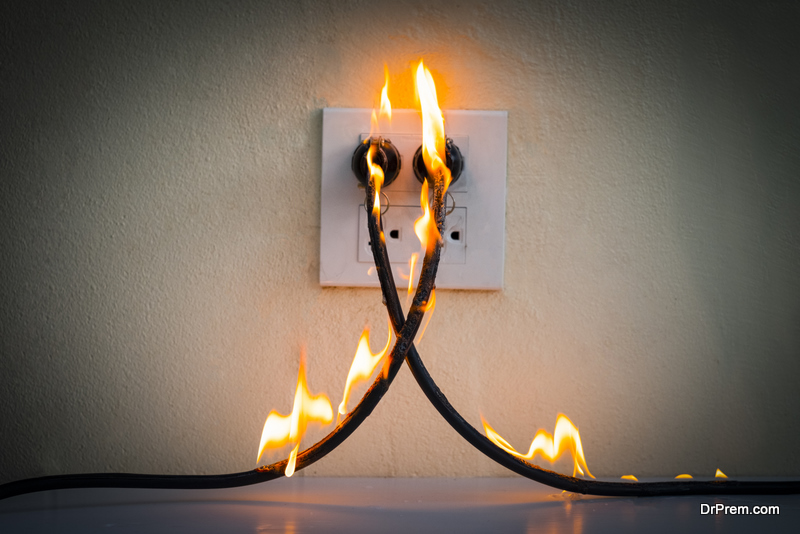An overloaded circuit in your home can cause a fire, damage your appliances and electronics, and even result in you getting an electrical shock. For these reasons, it’s important to know the warning signs of this problem and how to prevent this seemingly small electrical problem from getting much worse.
But, what is an overloaded circuit, exactly? And, how can you spot the problem before there’s damage to your home, or even worse, an injury to you or your family members?
We’ll explain all that in this article. In particular, we’ll cover:
- What Is An Overloaded Circuit In Your Home?
- Why Is An Overloaded Circuit Dangerous?
- Four Signs Of An Overloaded Circuit
- What To Do If You Suspect An Overloaded Circuit In Your Home
What Is An Overloaded Circuit In Your Home?
An overloaded circuit is when you’re trying to draw way too much electricity through a single circuit in your electric panel. Each circuit in your panel is designed to manage a certain amount of power, or current.
Why Is An Overloaded Circuit Dangerous?
An overloaded circuit can cause a fire. With too much electricity flowing through it, your appliances and electronics will receive more power than they can handle. That excess electricity fries inner components.
Meanwhile the wires will heat up. You can end up with sparks coming through the outlets. Or, the insulation around the hot wires catches on fire. It’s more common than you may think.
Four Signs Of An Overloaded Circuit
Now that you know the dangers of an overloaded circuit, here are four signs of this problem in your home:
- Warm Or Buzzing Outlets And Switches
- Flickering LIghts
- Malfunctioning Appliances And Electronics
- Burn Marks Or Burning Smells On Outlets And Switches
1. Warm or Buzzing Outlets And Switches
Too much electricity actively flowing through your wires can result in outlets and switches feeling warm or making a buzzing sound. You’re literally feeling or hearing the excess power!
But, that means you’re actively at risk of a fire. The wires serving up that electricity are warming up from the powerful current. And, as we mentioned, that could cause the insulation around them in the walls to catch fire.
Meanwhile, the outlet or switch itself is now a hazard. You could get burned or shocked from touching it.
2. Flickering Lights
Flickering lights are a sign of unstable current, and a leading cause of that is an overloaded circuit. You’re witnessing the ebbs and flows of excess electricity causing the bulbs to alternately burn brighter and dimmer.
3. Malfunctioning Appliances and Electronics
Every appliance and electronic in your home is made to accept a certain amount of voltage. Too little power and they may not power on or won’t work right. Plug-in tools might now work as powerfully, or a refrigerator might not get cold enough, for instance.
Too much power is also a problem. That’s when you run into damage to inner components. Just like the wiring in your house, those parts overheat from the excess electricity. Eventually, the parts will break.
4. Burn Marks or Burning Smells On Outlets And Switches
Burn marks and a burning smell is a serious problem! That current has been too strong for too long. If the warmth or buzzing on the outlets and switches were an early warning sign, this evidence of damage means you’re in serious trouble.
What to Do If You Suspect An Overloaded Circuit In Your Home
An overloaded circuit requires a professional — especially if you’re noticing damage to outlets, switches, or appliances and electronics. If you notice this problem, here’s what to do:
- Turn Off Lights, Appliances, And Electronics
- Manually Turn Off The Breaker In Your Electric Panel
- Call An Electrician
1. Turn Off Lights, Appliances, and Electronics
Your first step is reducing the amount of power you’re pulling through that circuit. That may not solve the problem for good, but it’s an important first step.
And, if you’ve been using more power in that part of the house lately, then this may solve the problem. You should still get your wiring checked out, but the issue may have just been that you were trying to draw too much power.
2. Manually Turn Off The Breaker In Your Electric Panel
The next step is turning off the breaker. That cuts all the power coming through taht circuit. On the one hand, you won’t be able to use any outlets or turn on any lights in that part of the house.
But, on the other hand, it’s an important safety precaution. That’s especially so if you’ve noticed the more severe symptoms of an overloaded circuit. Those would be things like the breaker constantly tripping, burning smells, and scorch marks on the outlets and switches.
3. Call an Electrician
Always call an electrician if you suspect an overloaded circuit! Even if you “solved” the problem by using less power, there’s still the very real possibility of damage to the wiring. While that may not cause an issue right away, you can end up with damage later on.
After all, you can’t see what’s going on behind your walls! There very well could be a damaged or melted wire that can cause a fire at any time.
And, you may need to have part of the house rewired. That’s a surefire way to prevent another overload by distributing the power needs more evenly.
Article Submitted By Community Writer




